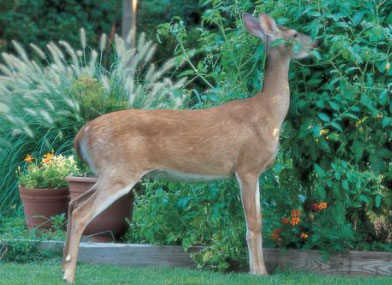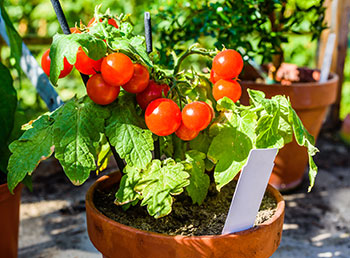Spring Landscaping
Spring Pest and Disease Control
Every day, Arkansas homes, lawns and gardens are under siege by destructive insects, diseases, weeds and wildlife. Follow our monthly checklist to prevent and cope with pests in your home landscape.
Fast Facts

The easiest way to reduce the risk of deer ruining your landscape is to use deer-resistant plants.
- Root rots are preventable by decreasing the length of time garden soil is saturated. Root rots are not curable once your garden plants exhibit decline.
- Identify garden pests before you attempt to control them. If you decide to use chemical control, read the label carefully. Indiscriminate use of pesticides can lead to a major infestation of spider mites.
- Reduce mosquito problems by turning over any pots, lids or saucers that might collect
water and create a breeding site. Use Bt dunks in ponds that have no fish in them. The Bt dunks are safe with fish;
but when fish are present, they will take care of mosquito larvae.
- Wear light-colored clothing, apply repellent, and get in the habit of checking yourself,
your children and pets closely for ticks after spending time outdoors.
- Monitor houseplants kept indoors for mealybugs, spider mites, aphids, whitefly, and
scale. If spider mites are a problem consider spraying with a labeled horticultural oil
or soap and pyrethrum mix. If possible, move the plants outside before spraying and
when dry, move them back indoors.
- Check out our page on Common Houseplant Problems.
March
- If the foliar disease called botrytis plagues your peony, begin spraying as soon as the foliage begins to emerge with a recommended fungicide containing chlorothalonil. Follow label recommendations for rate and frequency of application.
April
- After petals drop, consider spraying peach, plum, and cherry fruit trees for protection
from fungal diseases like brown rot, rust, and leaf spot. Maneb (also sold as mancozeb and dithane) works well for these diseases.
- For help identifying fruit tree diseases visit our page Fruit & Nut Tree Diseases
- Watch for eastern tent caterpillars found on many fruit trees including cherries, plums, peaches, nectarines, and crabapples. Webs develop on the inner crotches of limbs. Tear out webs in the evening and destroy.
This will eliminate the need to use a chemical spray. There is only one generation
of this insect and is only seen in the spring.
- Watch for European Pine Sawfly larvae (clusters of green “worms” with black heads) to start hatching on pines. Natural enemies, lack of adequate food, disease, or unfavorable weather usually combine to control sawfly populations.
May

Carefully select tomato and pepper transplants to avoid bacterial spot disease infested
plants. Don't purchase plants which have small, yellow-green spots or brown spots
on leaves. Once you get the disease in your garden, it's difficult to eliminate.
- If fire blight symptoms (leaves wilted and brown or black at branch tips) are severe in young apple and pear
trees, and tree structure is at risk, immediate pruning will be beneficial. Make cuts 6–8 inches below the infection. Sterilize pruners in between cuts. Burn
or destroy all diseased tissue.
- Pick off azalea leaf galls as they form. Put these fungus affected leaves in your
weekly trash pickup.
- Azaleas often show symptoms of lace bug and spider mite infestations during the hot months of summer. This damage can be prevented by a one-time, early application of the systemic insecticide
‘imidacloprid’. This insecticide should be poured in liquid form around the root system
as the flowers fade, spreading the active ingredients throughout the plant tissue
where it remains effective through the growing season.
- Treat scale crawlers on infested euonymus shrubs.
- Distorted or discolored new growth is a common sign of aphids. Spraying with insecticidal soap and blasting with a jet of water from the garden
hose are two safe and easy controls. The key to keeping their numbers down is persistence.
Check plants every few days for signs of reinfestation and treat as soon as possible.
- Begin spraying to control black spot disease. Be on the watch for downy mildew on your roses. We have had ideal weather for this devastating foliar disease.
- Control caterpillars on broccoli and cabbage plants by handpicking or use biological
sprays such as Bt.
- Place cutworm collars around young vegetable transplants. Collars are easily made from cardboard strips.
- Slugs will hide during the daytime beneath a board placed over damp ground. Check
each morning and destroy any slugs that have gathered on the underside of the board.
- Slugs will hide during the daytime beneath a board placed over damp ground. Check
each morning and destroy any slugs that have gathered on the underside of the board.
- Termites begin swarming. Termites can be distinguished from ants by their thick waists and straight antennae.
Ants have slender waists and elbowed antennae. Termites also have two pair of wings
which are the same length. Ant’s wings will be two different lengths.
- Spray trunks of peach trees and other stone fruits to prevent the next generation of borers. This insect is one of two reasons we should not plant stone fruits in our region. Organic methods have erratic results. To control peach tree borers in peaches, plums, cherries or nectarines, wet the lower 12 inches of the trunk and the ground around the trunk with a spray of materials containing permethrin or esfenvalerate as the active ingredient. Once is not good enough, do this monthly beginning end of May or early June with the last application in early August.
June
- Bag worms have hatched and are beginning to consume needled evergreens. Bag worms can kill junipers, arborvitae, cedars and similar needled evergreens if they get heavily infested. Inspect susceptible plants periodically. Hand-picking of light infestations works well or applying the bacteria Bacillus thuringiensis.
- Squash bugs become active in warm days and move to germinating squash. Squash bug eggs are shiny, slightly oval, and copper colored. Inspect leaves regularly and collect eggs by tearing off a small portion of the leave. Mixtures of nymphs and adults occur together in large masses. Place boards at the base of plants, and flip over at sunrise, to destroy emerging populations.
- If you have a history of squash vine borers, and do not want to use insecticides, delay planting until July. Early plantings are targeted by the spring flush of overwintering pupae. Later plantings are exposed to fewer. In Arkansas the squash vine borer has two generations per year with the second emerging around August.
- Garden insects such as corn earworm, cucumber beetle, squash vine borer, squash bugs and flea beetles can become problematic. Corn ear worm can easily be prevented by placing several drops of mineral oil laced with Bacillus thuringiensis, onto newly emerged silks.
- Adult Japanese beetles will begin emerging this month. Take control measures early, never let a large number of beetles to congregate on your plants. Their presence, and because of the pheromone they release, will attract more. Hand-removal works. If the population gets out of control, you will need to resort to chemical products such as carbaryl (Sevin, etc.), which is very effective. Observe all label precautions on mixing and use. Do not use dusts due to the problem with application - a spray made using the liquid form of the product will work fine.
- Sawflies have made their presence known on roses (called rose slug) and on pine trees. Control them early to prevent total defoliation as well as a second generation.
- Are your rose buds or other flower buds having trouble opening? Your problem might be caused by an insect. Thrips feed on flower buds and opened flowers causing them to turn brown. They cause leaf undersides to appear dirty and silvery. They are slender, minute and appear yellow brown in color and transparent. Thrips are especially bad on gladiolus and will prevent flowers from opening.
Got pest questions? We have answers.
Check out the Plant Health Clinic